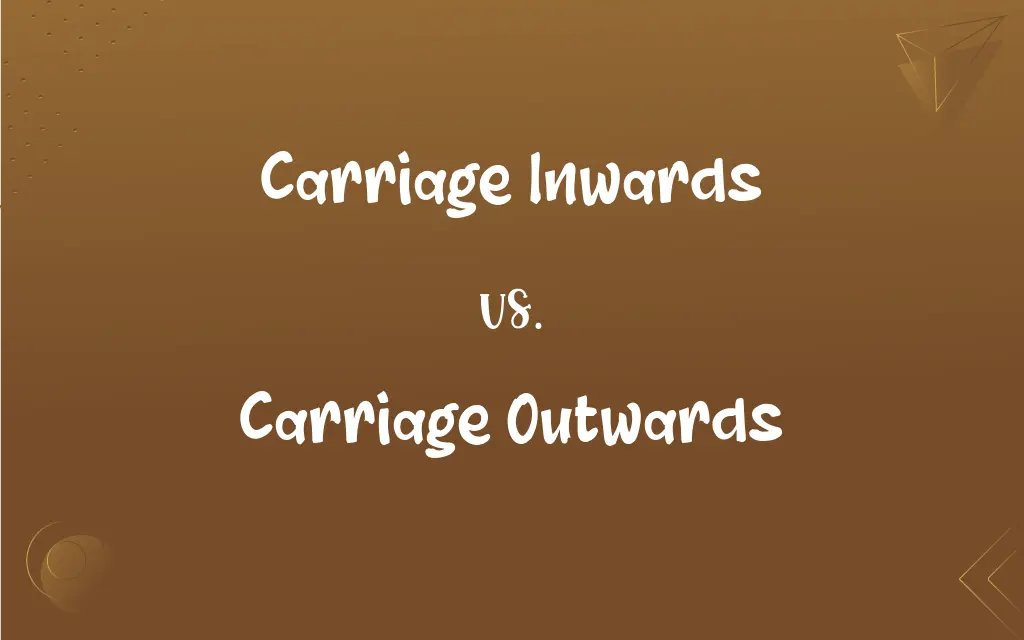Carriage Inwards vs. Carriage Outwards: What's the Difference?
Edited by Aimie Carlson || By Janet White || Published on December 8, 2023
Carriage inwards refers to the cost of transporting goods into a business, while carriage outwards is the cost of shipping goods out to customers.

Key Differences
Carriage inwards is an expense incurred when a business receives goods, typically included in the cost of purchases. Carriage outwards, on the other hand, involves expenses when a business sends goods to its customers, often seen as a distribution cost.
Carriage inwards is accounted for in the cost of goods, affecting the purchase price and inventory valuation. In contrast, carriage outwards is usually recorded as a selling expense, impacting the profit and loss account.
Carriage inwards is a part of the procurement process, impacting the initial investment in inventory. Conversely, carriage outwards is associated with the sales process, affecting the delivery of goods to customers.
In financial accounting, carriage inwards is often categorized under 'direct expenses'. Carriage outwards is considered an 'indirect expense' as it relates to the broader activity of selling and distribution.
Carriage inwards affects the cost base of inventory, thereby influencing gross profit margins. Carriage outwards, however, affects the operational expenses, influencing net profit margins.
ADVERTISEMENT
Comparison Chart
Definition
Cost of transporting goods into a business.
Cost of shipping goods out to customers.
Accounting Treatment
Included in the cost of purchases.
Recorded as a selling expense.
Impact on Financials
Affects purchase price and inventory valuation.
Affects profit and loss account.
Related to
Procurement process.
Sales and distribution process.
Expense Category
Direct expense.
Indirect expense.
ADVERTISEMENT
Carriage Inwards and Carriage Outwards Definitions
Carriage Inwards
Carriage inwards is factored into the purchase price of goods.
The accounting records showed carriage inwards as part of the inventory acquisition cost.
Carriage Outwards
Carriage outwards is often an indirect cost related to sales.
The business noted an increase in carriage outwards due to expanded online sales.
Carriage Inwards
Carriage inwards is the cost incurred for bringing goods into a business.
The carriage inwards was added to the total cost of the new inventory.
Carriage Outwards
It affects the selling and distribution expenses of a business.
Higher carriage outwards impacted the company's operational costs.
Carriage Inwards
Carriage inwards is often a direct cost linked to purchasing.
Carriage inwards increased the overall investment in the stock.
Carriage Outwards
Carriage outwards is the cost associated with sending goods to customers.
The company's carriage outwards was billed separately on the customer's invoice.
Carriage Inwards
It impacts the cost of goods sold in a business.
The company's carriage inwards contributed to the higher cost of goods this quarter.
Carriage Outwards
It represents transportation expenses for outgoing goods.
Carriage outwards for the month totaled a significant portion of delivery expenses.
Carriage Inwards
It represents transportation expenses for incoming goods.
The invoice included a charge for carriage inwards for the delivered materials.
Carriage Outwards
Carriage outwards is typically a part of a company’s selling expenses.
The annual report showed a rise in carriage outwards in line with increased sales.
FAQs
What does carriage inwards mean?
It refers to the cost of transporting goods into a business.
Is carriage inwards a direct or indirect expense?
Carriage inwards is a direct expense, directly affecting the cost of goods.
Do carriage inwards costs vary?
Yes, they can vary based on distance, volume, and transportation method.
Can carriage outwards impact gross profit?
No, it affects operational expenses and thereby influences net profit.
What is carriage outwards?
It's the cost incurred when a business sends goods to its customers.
How is carriage inwards recorded in accounting?
It's included in the cost of purchases and affects inventory valuation.
Where is carriage outwards reported financially?
It's reported as a selling expense in the profit and loss account.
How do carriage inwards affect pricing strategy?
They can influence the pricing of products by affecting the overall cost.
Can carriage inwards vary seasonally?
Yes, factors like seasonal demand and shipping rates can affect these costs.
Are carriage inwards and carriage outwards always present in businesses?
They occur in businesses that deal with physical goods requiring transportation.
Are carriage inwards and outwards tax-deductible?
Generally, they are considered as business expenses and are tax-deductible.
Can carriage outwards be a competitive factor?
Yes, efficient carriage outwards can enhance customer satisfaction and competitiveness.
Should carriage inwards be closely monitored?
Yes, to ensure cost-effectiveness and accurate inventory valuation.
Are carriage inwards and outwards affected by scale?
Yes, larger scale operations might achieve efficiencies in these costs.
Is carriage outwards a factor in e-commerce?
Absolutely, it's a significant consideration in the overall cost structure of e-commerce businesses.
Can a business reduce carriage outwards expenses?
Yes, by optimizing delivery routes, consolidating shipments, or negotiating with carriers.
How can technology affect carriage outwards?
Advanced logistics and routing software can optimize and reduce these costs.
Is carriage outwards relevant for all types of sales?
It's mainly relevant for physical products that require delivery to customers.
Can carriage inwards be passed on to customers?
Typically, it's factored into the cost of goods rather than directly billed to customers.
How do carriage inwards impact inventory management?
They add to the total investment in inventory, affecting management decisions.
About Author
Written by
Janet WhiteJanet White has been an esteemed writer and blogger for Difference Wiki. Holding a Master's degree in Science and Medical Journalism from the prestigious Boston University, she has consistently demonstrated her expertise and passion for her field. When she's not immersed in her work, Janet relishes her time exercising, delving into a good book, and cherishing moments with friends and family.
Edited by
Aimie CarlsonAimie Carlson, holding a master's degree in English literature, is a fervent English language enthusiast. She lends her writing talents to Difference Wiki, a prominent website that specializes in comparisons, offering readers insightful analyses that both captivate and inform.







































































